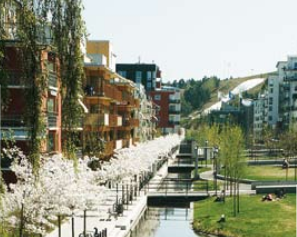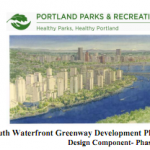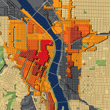Please list each reference in a category that would be of interest to others. After the author, title and publication information or source link, add your initials linked to a brief blog post that summarizes the major content and explains what you found useful. Zotero will generate bibliographic entries in MLA style.
- Thesis
- Productivity Tools
- EcoDistricts
- Portland’s Urban Ecology
- Urban Design
- Digital / Material Studies
- Biomimicry
- Landscape and Water
- Site Analysis
- Education
1. Thesis & Innovation
- Brilliant Simplicity – inspiring stories of how design research innovation happens, by Susan Szenasy Editor-in-Chief of Metropolis Magazine.
- Holcim Awards for Sustainable Construction. considers Technical innovation & transferability, Social equity, Economic performance & Aesthetics.
- Archiprix International – best Architecture, Urban Design and Landscape Architecture graduation projects
- Little Thesis from MIT Architecture… download the PDF of Volume 2 for lots of advice. It was initiated by Haruki Horiuchi, who got the Thesis Prize. See her blog.
- Thesis Prep Document Work in Progress by Dan Edleson-Stein in Eugene: Click on Portfolio > PIU > Thesis Draft
- Royal Melbourne Institute of Technology Thesis Projects– catalog with Thesis Statements
 Harvard GSD’s year 2008-2009 (photo linked). Organized thematically: Form-processes, Geography-contested grounds, Invention-conditional utopias, Transformation-adaptive response, Authorship-open source, Practice- modes of practical knowledge. recommended by Alana Armstrong
Harvard GSD’s year 2008-2009 (photo linked). Organized thematically: Form-processes, Geography-contested grounds, Invention-conditional utopias, Transformation-adaptive response, Authorship-open source, Practice- modes of practical knowledge. recommended by Alana Armstrong Rafael Moneo: Theoretical Anxiety & Design Strategies. Contemporary Architects examined by Rafael Moneo on personal design theories & their design strategies.
Rafael Moneo: Theoretical Anxiety & Design Strategies. Contemporary Architects examined by Rafael Moneo on personal design theories & their design strategies.
2. Productivity Tools
3. EcoDistricts
 Publications: Framework, Making Ecodistricts and pilot ecodistrict reports are particularly recommended
Publications: Framework, Making Ecodistricts and pilot ecodistrict reports are particularly recommended Hammarsby, Sweden. Detailed brochure explains context, development and technical aspects of a sustainable city.
Hammarsby, Sweden. Detailed brochure explains context, development and technical aspects of a sustainable city.
4. Portland’s Urban Ecology
 The Portland Natural Resources Inventory explains what characteristics of land are considered valuable from a habitat point of view. It describes the different kinds of wildlife habitats in Portland and how connectivity as well as quality are considered. The Portland Plan NRI 2009 version gives a graphic overview with images and data about the different watersheds. The Central City NRI June 2011 version’s Section 4 has extensive detail on the Lloyd District with a narrative about the amount and type of birds, fish and plants, etc. The report explains the process for assessing the value of ecosystem assets and which areas should be protected. Created by Portland’s Bureau of Planning and Sustainability, Central City 2035, Bureau of Environmental Services, Portland Parks and Recreation, and the office of Healthy Working Rivers.
The Portland Natural Resources Inventory explains what characteristics of land are considered valuable from a habitat point of view. It describes the different kinds of wildlife habitats in Portland and how connectivity as well as quality are considered. The Portland Plan NRI 2009 version gives a graphic overview with images and data about the different watersheds. The Central City NRI June 2011 version’s Section 4 has extensive detail on the Lloyd District with a narrative about the amount and type of birds, fish and plants, etc. The report explains the process for assessing the value of ecosystem assets and which areas should be protected. Created by Portland’s Bureau of Planning and Sustainability, Central City 2035, Bureau of Environmental Services, Portland Parks and Recreation, and the office of Healthy Working Rivers. The Central City 2035 River Plan – Central Reach, Existing Policies and Conditions consolidates crucial planning information such as urban design, transportation, land ownership, recreation, and natural resources for the area from the South Waterfront to the 405 bridge. It uses maps, 3D models, and matrices to catalog existing assets. Policy summaries, map of Green Infrastructure, and conceptual sections are especially valuable. The report was created by a City of Portland Bureau of Planning and Sustainability team lead by Sallie Edmunds of the City of Portland
The Central City 2035 River Plan – Central Reach, Existing Policies and Conditions consolidates crucial planning information such as urban design, transportation, land ownership, recreation, and natural resources for the area from the South Waterfront to the 405 bridge. It uses maps, 3D models, and matrices to catalog existing assets. Policy summaries, map of Green Infrastructure, and conceptual sections are especially valuable. The report was created by a City of Portland Bureau of Planning and Sustainability team lead by Sallie Edmunds of the City of Portland The Willamette River Design Notebook by Greenworks explains how to treat the riverbank edge to accommodate both natural and human activities.
The Willamette River Design Notebook by Greenworks explains how to treat the riverbank edge to accommodate both natural and human activities. The SouthWaterfront Greenway Plan of 2004 has a concise environmental and cultural history that is very informative. Compared to graphic bullet points of the South Waterfront Design Guidelines of 2010 with great visual environmental design examples, it has a readable account about the natural ecology written by ecologists and landscape specialists.
The SouthWaterfront Greenway Plan of 2004 has a concise environmental and cultural history that is very informative. Compared to graphic bullet points of the South Waterfront Design Guidelines of 2010 with great visual environmental design examples, it has a readable account about the natural ecology written by ecologists and landscape specialists. Restoring Rare Native Habitats in the Willamette Valley: A Landowner’s Guide for Restoring Oak Woodlands, Wetlands, Prairies, and Bottomland Hardwood and Riparian Forests. This document explains how to restore land from the planning and assessment stage to providing water, prepping the site, planting and removing invasives.
Restoring Rare Native Habitats in the Willamette Valley: A Landowner’s Guide for Restoring Oak Woodlands, Wetlands, Prairies, and Bottomland Hardwood and Riparian Forests. This document explains how to restore land from the planning and assessment stage to providing water, prepping the site, planting and removing invasives. Integrating Habitats, Design Competitionsponsored by Metro’s Nature in Neighborhood group, this competition spawned new ideas for how humans and fish and wildlife can coexist. Browse winning schemes, see brief videos of the winners, and oak savannah habitat, riparian forest and lowland hardwood forest.The lovely competition brief by Brook Muller and Josh Cerra http://www.oregonmetro.gov/index.cfm/go/by.web/id=27420#documents features concise narratives about the habitats as well as a handy guide to stormwater management. It is illustrated with UO student work.
Integrating Habitats, Design Competitionsponsored by Metro’s Nature in Neighborhood group, this competition spawned new ideas for how humans and fish and wildlife can coexist. Browse winning schemes, see brief videos of the winners, and oak savannah habitat, riparian forest and lowland hardwood forest.The lovely competition brief by Brook Muller and Josh Cerra http://www.oregonmetro.gov/index.cfm/go/by.web/id=27420#documents features concise narratives about the habitats as well as a handy guide to stormwater management. It is illustrated with UO student work. Houck, Mike and M. J. Cody, Wild in the City: Exploring the Intertwine: The Portland-Vancouver Region’s Network of Parks, Trails, and Natural Areas. A guide to exploring nature in Portland by the Audubon Society’s Urban Naturalist Mike Houck who has won multiple awards for “restoring and preserving the natural world within urban environments”.
Houck, Mike and M. J. Cody, Wild in the City: Exploring the Intertwine: The Portland-Vancouver Region’s Network of Parks, Trails, and Natural Areas. A guide to exploring nature in Portland by the Audubon Society’s Urban Naturalist Mike Houck who has won multiple awards for “restoring and preserving the natural world within urban environments”.
5. Urban Design
 Urban Design Studio, City of Portland. See Design Central City, Area Design Guidelines
Urban Design Studio, City of Portland. See Design Central City, Area Design Guidelines Rose Quarter District Plan by Mike McCulloch shows his vision for enlivening the area with infill development, open space definition and habitat connectivity.
Rose Quarter District Plan by Mike McCulloch shows his vision for enlivening the area with infill development, open space definition and habitat connectivity. Duany, Andres, Jeff Speck, and Mike Lydon. The Smart Growth Manual. New York: McGraw-Hill, 2010.This is a great book for a good rules of thumbs and a better understanding of city development. The short subsections make it real easy to breeze through but also make finding information on a certain topic quick. click on the image to preview the book and possibly buy. Enjoy – recommended by Nick Byers
Duany, Andres, Jeff Speck, and Mike Lydon. The Smart Growth Manual. New York: McGraw-Hill, 2010.This is a great book for a good rules of thumbs and a better understanding of city development. The short subsections make it real easy to breeze through but also make finding information on a certain topic quick. click on the image to preview the book and possibly buy. Enjoy – recommended by Nick Byers- Krauel, Jacobo. Urban Spaces. Barcelona, Spain: LINKS, 2009. Print.KW
- Krier, Rob. Urban Space. London: Rizzoli, 1979. Print.KW
6. Digital / Material Studies
- Nancy’s Digital Design Links
- Kinoshi, Miho. “an online exploration of LIGHT.FORM.” AA Intermediate Unit 3. Web. 5 Oct. 2010. NYC
- Achim Menges, Stuttgart University
- Frei Otto , Institute for Lightweight Structures (ILEK) Stuttgart
- Mark West, CAST, University of Manitoba,
- Skylar Tibbets, TED talk
- Gramazio & Kohler
- AA School Project Review
Biomimicry
 Biomimicry For Green Design (A How-To) by Jeremy Faludi
Biomimicry For Green Design (A How-To) by Jeremy Faludi
Stanford design professor explains biomimicry methods in plain language on the amazing Worldchanging website.
Petra Gruber’s Biomimetics in Architecture illustrates how architects have applied biomimicry principles to building design for planning, structure, ventilation, skins, etc. Profusely illustrated 2011 volume.
Neal Panchuk’s Thesis on Biomimicry and its Application to Digital Architecture, University of Waterloo, 2006. Strong illustrated research- Benyus, Janine, Biomimcry: Innovation Inspired by Nature, Harper Perennial, 2002. NYC
 http://www.youtube.com/watch?v=70ba1DByUmM&feature=player_embedded M.T.
http://www.youtube.com/watch?v=70ba1DByUmM&feature=player_embedded M.T. asknature.org M.T.
asknature.org M.T. http://biomimetic-architecture.com/ M.T.
http://biomimetic-architecture.com/ M.T. Dollen, Dennis. “Digital-Biomimetic Architecture.” Arte, Arquitectura Y Sociedad Digital. By Lourdes Cirlot. [Barcelona]: Publicacions I Edicions [Universitat De Barcelona, 2007. 145-55. Print. M.T.
Dollen, Dennis. “Digital-Biomimetic Architecture.” Arte, Arquitectura Y Sociedad Digital. By Lourdes Cirlot. [Barcelona]: Publicacions I Edicions [Universitat De Barcelona, 2007. 145-55. Print. M.T. Swackhamer, Marc, and Blair Satterfield. “Houminn – OSWall – Oswall Formatted for Web1.jpg.” Houminn – Blog. 2009. Web. 16 Nov. 2010. MLM
Swackhamer, Marc, and Blair Satterfield. “Houminn – OSWall – Oswall Formatted for Web1.jpg.” Houminn – Blog. 2009. Web. 16 Nov. 2010. MLM
Landscape and Water
 Artful Rainwater Design by Stuart Echols and Eliza Pennypacker of Penn State illustrates excellent examples of stormwater design, contains graphic presentations and links. See their essay that explains the rationale.
Artful Rainwater Design by Stuart Echols and Eliza Pennypacker of Penn State illustrates excellent examples of stormwater design, contains graphic presentations and links. See their essay that explains the rationale. Spirn, Anne Whiston. http://books.google.com/books?id=pRyh6iVkWj8C&Language of LandscapeYale University Press, 2000
Spirn, Anne Whiston. http://books.google.com/books?id=pRyh6iVkWj8C&Language of LandscapeYale University Press, 2000
 Willamette Riverbank Design Notebook: A tool created by Green Works designed to foster creativity and innovation in developing an urban river’s edge that improves conditions for fish, wildlife, and people. This document has contains a wealth of information concerning conditions of the Willamette riverbankhttp://www.pdc.us/pdf/dev_serv/pubs/willamette_riverbank_design_notebook.pdf M.T.
Willamette Riverbank Design Notebook: A tool created by Green Works designed to foster creativity and innovation in developing an urban river’s edge that improves conditions for fish, wildlife, and people. This document has contains a wealth of information concerning conditions of the Willamette riverbankhttp://www.pdc.us/pdf/dev_serv/pubs/willamette_riverbank_design_notebook.pdf M.T. City of Portland’s Bureau of Environmental Management Stormwater Solutions
City of Portland’s Bureau of Environmental Management Stormwater Solutions Water Management A very promising website out of California that is basically a clearinghouse for water resource management information:
Water Management A very promising website out of California that is basically a clearinghouse for water resource management information:
Infrastructure
 “Infrastructural Ecologies: Principles for Post-Industrial Public Works.” Design Observer. Hilary Brown. 10.15.10 MLM
“Infrastructural Ecologies: Principles for Post-Industrial Public Works.” Design Observer. Hilary Brown. 10.15.10 MLM
Site Analysis Graphics
- Visual Examples of Site Analysis, Programming diagrams and Conceptual Models collected by Nancy Cheng
Education
 DesignShare. Web. 10 Jan. 2011. <http://www.designshare.com/>.
DesignShare. Web. 10 Jan. 2011. <http://www.designshare.com/>.- Nair, Prakash, Randall Fielding, and Jeffery A. Lackney. The Language of School Design: Design Patterns for 21st Century Schools. [Minneapolis, Minn.]: DesignShare, 2009. Print. KLA
- Louv, Richard. Last Child in the Woods: Saving Our Children from Nature-deficit Disorder. Chapel Hill, NC: Algonquin of Chapel Hill, 2008. Print. KLA
